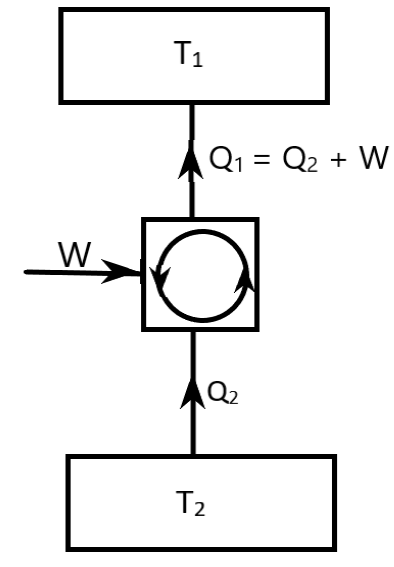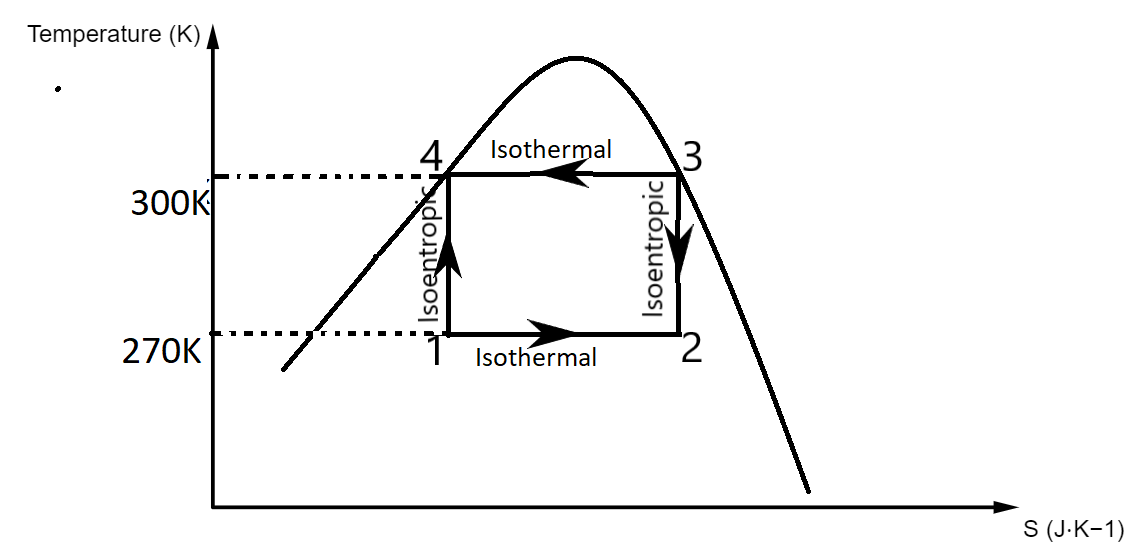
A Carnot refrigeration cycle absorbs heat at
A.
B.
C.
D.
Answer
455.7k+ views
Hint: In the Carnot Cycle, heat flows from higher temperature to lower temperature without external work, naturally. But, by doing some work this can be reversed i.e., heat can be made to flow from low temperature to high temperature. The cycle obtained after reversing is called the Carnot refrigeration cycle.
Formula used:
Complete answer:
This Carnot Refrigerator Cycle represents a reverse heat engine cycle or a refrigerator cycle. It is drawn in the below diagram.

Here,
In the diagram,
The Coefficient of Performance of the refrigerator expresses the efficiency of the refrigerator. It is given by
From these numbers mentioned in that question, we have
Using this data and the above formula, we can find the work done required per second
So, the correct answer is “Option A”.
Additional Information:
The Carnot refrigeration cycle is a graph drawn for Temperature vs Entropy.
Let us draw the graph to understand it better.

The curved part is called the Rankine curve.
In the graph,
1 to 2 denotes isothermal process
2 to 3 denotes isentropic process
3 to 4 denotes isothermal process
Note:
Don’t confuse Carnot Cycle for Carnot Refrigeration Cycle, both are contrary to each other. We can say that the Carnot refrigeration cycle is a reverse Carnot Cycle. The Carnot refrigeration cycle is a discipline of Thermal Prime Movers, an integral part of Mechanics. The COP is similar to that of the efficiency of a heat engine.
Formula used:
Complete answer:
This Carnot Refrigerator Cycle represents a reverse heat engine cycle or a refrigerator cycle. It is drawn in the below diagram.

Here,
In the diagram,
The Coefficient of Performance of the refrigerator expresses the efficiency of the refrigerator. It is given by
From these numbers mentioned in that question, we have
Using this data and the above formula, we can find the work done required per second
So, the correct answer is “Option A”.
Additional Information:
The Carnot refrigeration cycle is a graph drawn for Temperature vs Entropy.
Let us draw the graph to understand it better.

The curved part is called the Rankine curve.
In the graph,
1 to 2 denotes isothermal process
2 to 3 denotes isentropic process
3 to 4 denotes isothermal process
Note:
Don’t confuse Carnot Cycle for Carnot Refrigeration Cycle, both are contrary to each other. We can say that the Carnot refrigeration cycle is a reverse Carnot Cycle. The Carnot refrigeration cycle is a discipline of Thermal Prime Movers, an integral part of Mechanics. The COP is similar to that of the efficiency of a heat engine.
Latest Vedantu courses for you
Grade 8 | CBSE | SCHOOL | English
Vedantu 8 CBSE Pro Course - (2025-26)
School Full course for CBSE students
₹45,300 per year
Recently Updated Pages
Master Class 11 Business Studies: Engaging Questions & Answers for Success

Master Class 11 Economics: Engaging Questions & Answers for Success

Master Class 11 Accountancy: Engaging Questions & Answers for Success

Master Class 11 Computer Science: Engaging Questions & Answers for Success

Master Class 11 English: Engaging Questions & Answers for Success

Master Class 11 Maths: Engaging Questions & Answers for Success

Trending doubts
Which one is a true fish A Jellyfish B Starfish C Dogfish class 11 biology CBSE

Difference Between Prokaryotic Cells and Eukaryotic Cells

1 ton equals to A 100 kg B 1000 kg C 10 kg D 10000 class 11 physics CBSE

1 Quintal is equal to a 110 kg b 10 kg c 100kg d 1000 class 11 physics CBSE

One Metric ton is equal to kg A 10000 B 1000 C 100 class 11 physics CBSE

How much is 23 kg in pounds class 11 chemistry CBSE




